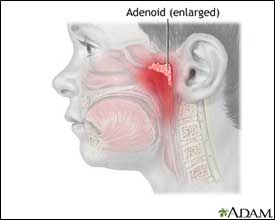
Adenoidectomy is the surgical removal of the adenoids. Adenoids are made of tissue located in the back of the nose near the throat. Adenoids and tonsils are part of the lymphatic system that helps trap germs that enter the body through the mouth and nose. The lymphatic system clears infection and controls the balance of fluid in the body. In children, the adenoids are thought to be involved in developing immunity against infections. They usually begin to shrink after age five and, by the teenage years, the body develops alternative ways to fight infection, so the adenoids are no longer needed.
Anatomy of the Adenoids

Source: www.medlineplus.gov
Symptoms of Enlarged Adenoids
If the adenoids are enlarged, it may be hard to breathe through the nose and breathing during sleep also may be disturbed. The American Academy of Otolaryngology lists other signs of adenoid enlargement as:
- Breathing through the mouth instead of the nose most of the time.
- Nose sounds blocked when the person speaks.
- Chronic runny nose.
- Noisy breathing during the daytime.
- Recurrent ear infections over the course of a year.
- Excessive snoring at night.
- Restlessness during sleep, which may indicate sleep apnea, a condition characterized by breathing that stops repeatedly for a few seconds at a time.
How are Enlarged Adenoids Diagnosed?
Enlarged adenoids can make it hard for your child to breathe through the nose, resulting in mouth breathing. This may cause:
- A dry mouth, which can lead to bad breath.
- Cracked lips.
- A runny nose.
To diagnose enlarged adenoids, your health care provider will take a medical history, and check the ears, throat, mouth, and neck. Since the adenoids are higher up than the throat, a physician cannot see them just by looking through the mouth. To check the size of your child’s adenoids, they may use:
- A special mirror in the mouth.
- A long, flexible tube with a light (an endoscope).
- An x-ray.
When is Adenoidectomy Recommended?
Adenoidectomy is typically performed on young children to remove enlarged adenoids that cause problems by blocking the nasal passage, or the opening to the sinuses or middle ear. It may be used to treat long-term sinus infections and recurrent ear infections or chronic ear fluid. An adenoidectomy to remove the adenoids may be recommended if:
- There have been repeated infections of the adenoids. Sometimes the infections can also cause ear infections and fluid buildup in the middle ear.
- Antibiotics were not effective in getting rid of a bacterial infection.
- The enlarged adenoids block the airways.
What to Expect Prior to the Procedure
Prior to adenoidectomy your doctor will likely do the following:
- Physical exam of the tonsils, throat, and neck.
- A blood test.
- Review your child’s medications—you may be asked to stop giving some medications to your child up to 1 week before the procedure.
- Order x-rays.
The patient should not eat or drink anything for at least 8 hours prior to the procedure.
Description of an Adenoidectomy Procedure
Typically general anesthesia is used in adenoidectomy procedures. It will block any pain and keeps the patient asleep throughout the procedure. The adenoids usually are surgically removed through the mouth, and occasionally through the nose. A scalpel or another type of tool will be used to remove the adenoid tissue, and an electrical current also may be used. Gauze packs will be placed at the site of the procedure to prevent bleeding.
Radiofrequency ablation is a type of procedure that uses heat to destroy tissue. It may be used to reduce the volume and size of the adenoids. This method often has less bleeding and seems to cause less pain.
Immediately After the Procedure
Adenoidectomy usually takes less than 45 minutes. Following the procedure, your child will be monitored in a recovery room until the anesthesia wears off. Adenoidectomy often is done as an outpatient procedure, but your doctor may choose to keep him or her overnight if there appear to be any complications.
How Much Will It Hurt?
Anesthesia prevents pain during surgery. Pain and discomfort after the procedure can be managed with medications.
Post-procedure Care
Recovery from adenoidectomy will take 7-14 days. After the procedure, your child may have:
- Light bleeding
- Nasal stuffiness or drainage
- Sore throat
- Bad breath
- Difficulty swallowing
- Ear or throat pain
- Stiff or sore neck
- Nasal speech
To help relieve some discomfort and speed recovery:
- Eat light meals of soft foods for the first several days.
- Avoid hot liquids.
- Take prescribed antibiotics to prevent infection.
- Take pain medication as needed.
- Avoid swimming and rough or intense exercise.
- Avoid forceful nose blowing.
There also are steps you can take to reduce your child’s chance of infection following adenoidectomy. These include:
- Washing his or her hands often and reminding your healthcare providers to do the same.
- Reminding your healthcare providers to wear gloves or masks.
Potential Complications
Problems from the procedure are rare, but all procedures have some risk. Your doctor will review potential problems, like:
- Bleeding
- Infection
- Dehydration from difficulty taking fluids
- Regrowth of adenoid tissue
- A permanent change in voice
- Reaction to anesthesia
Before your procedure, talk to your doctor about ways to manage factors that may increase your risk of complications such as:
- Smoking
- Drinking
- Chronic diseases, such as diabetes or obesity
Sources:
American Academy of Otolaryngology: www.entnet.org
Medline Plus - Adenoids: medlineplus.gov
If you suspect you or a family member are a candidate for an adenoidectomy, please consult your healthcare provider. Dr. Paul Lenkowski of LewisGale Physicians is available to answer all of your questions. To schedule an appointment, call the practice at 540) 444-8100 or book an appointment online below.